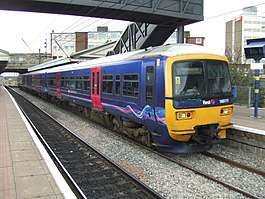Hayes & Harlington railway station
| Hayes & Harlington |
|
|---|---|

A First Great Western stopping service from Oxford to Paddington at the station
|
|
|
Location of Hayes & Harlington in Greater London
|
|
| Location | Hayes and Harlington |
| Local authority | London Borough of Hillingdon |
| Managed by | Great Western Railway |
| Station code | HAY |
| DfT category | D |
| Number of platforms | 5 |
| Fare zone | 5 |
| National Rail annual entry and exit | |
| 2011–12 |
|
| 2012–13 |
|
| 2013–14 |
|
| 2014–15 |
|
| 2015–16 |
|
| Other information | |
| Lists of stations | |
| External links | |
| WGS84 | 51°30′07″N 0°25′12″W / 51.502°N 0.4201°WCoordinates: 51°30′07″N 0°25′12″W / 51.502°N 0.4201°W |
|
|
|
Hayes & Harlington is a railway station in Hayes and Harlington in the London Borough of Hillingdon which is in West London.
The station is on Isambard Kingdom Brunel's former Great Western Main Line running out of London Paddington to the Thames Valley, Bristol, South Wales and the West Country. The line was opened on 4 June 1838, initially running to a temporary Maidenhead station to allow completion of the famous brick arch bridge over the River Thames just west of the station. The station at Hayes opened in 1868.
From 1 March 1883, the station (then named Hayes) was served by District Railway services running between Mansion House and Windsor. The service was discontinued as uneconomic after 30 September 1885.
The film Trains at Hayes Station, showing trains passing through the station with stereophonic sound, was filmed from the roof of the defunct Aeolian pianola factory just north of the station. The factory had been purchased by HMV when the pianola company had collapsed owing to fraud and technological obsolescence. The film is almost the first demonstration of stereophonic sound to accompany moving pictures, an invention of Alan Blumlein.
The station has five platforms, four being through platforms and one being a terminus bay platform. Platforms 1-2 are used only during engineering works; platforms 3 & 4 are for stopping services to and from Heathrow Airport, Reading and Oxford; platform 5 is a bay terminus platform, which is sometimes used during peak times, amended services and during engineering works. Platform 5 is capable of holding an eight-car train; platforms 2, 3 and 4 can hold seven-car trains and platform 1 can hold a five-car trains. All lines at Hayes & Harlington are electrified. On platform 5 there is an alternative entrance leading to High Point Hayes, the entrance has Oyster Pay & Go readers, platforms 3 & 4 are connected by a bridge towards the end of the platforms.
...
Wikipedia

